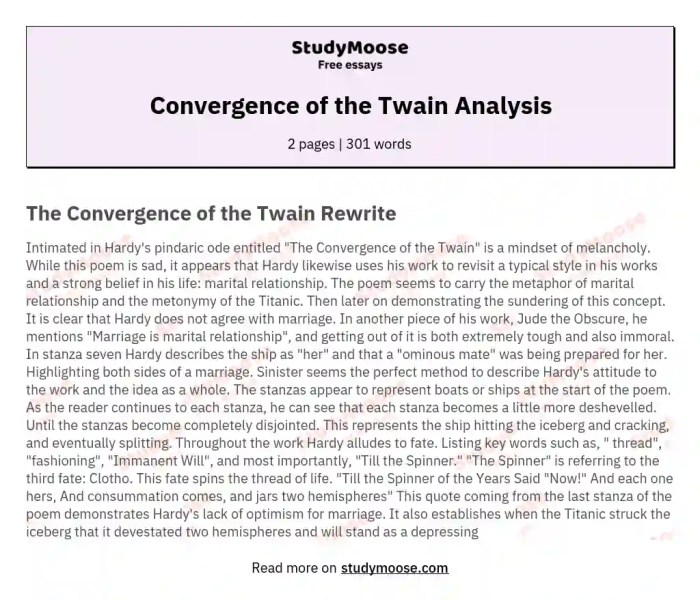The analysis of the convergence of the twain delves into the profound impact of technological advancements that connected the East and West, reshaping the world in unprecedented ways. This transformative event sparked a cascade of historical, cultural, and economic consequences that continue to resonate today.
From the construction of the transcontinental railroad to the invention of the telegraph, the convergence of the twain accelerated transportation, communication, and trade, fostering global interconnectedness and economic growth.
Historical Context
The convergence of the twain, a phrase coined by Mark Twain, refers to the meeting of the Atlantic and Pacific Oceans at the Panama Canal. This event, completed in 1914, had profound historical significance, marking a new era of global connectivity and trade.
Twain’s novel, “The Gilded Age,” played a pivotal role in shaping public perception of the convergence of the twain. The novel satirized the corruption and greed associated with the canal’s construction, exposing the dark underbelly of American capitalism.
Cultural Impact
The convergence of the twain had a transformative impact on American culture. It fostered a sense of national pride and unity, as the canal symbolized the country’s technological prowess and global reach.
The event also inspired a surge in artistic expression. Writers, painters, and musicians found inspiration in the grandeur and significance of the canal, creating works that celebrated its engineering marvels and its impact on society.
Technological Advancements
The construction of the Panama Canal was a testament to the ingenuity and technological advancements of the early 20th century. Engineers overcame formidable challenges, including disease, landslides, and treacherous terrain, to complete the colossal project.
The canal’s construction revolutionized transportation and communication. It shortened shipping routes between the Atlantic and Pacific, reducing travel times and costs. It also facilitated the exchange of ideas and cultures, fostering global connectivity.
Economic Consequences

The convergence of the twain had far-reaching economic consequences. The canal opened new markets for American goods, boosting trade and economic growth. It also created new industries, such as tourism and shipping, and led to the development of new port cities.
However, the canal’s construction also had negative economic impacts. The influx of workers from around the world led to labor disputes and social tensions. The canal’s environmental impact also raised concerns, as it disrupted ecosystems and introduced invasive species.
Social Changes
The convergence of the twain triggered significant social changes. The construction of the canal attracted a diverse workforce, leading to increased cultural exchange and the formation of new social networks.
The canal also facilitated migration, as people from around the world sought opportunities in the newly connected regions. This led to the growth of cosmopolitan cities and the emergence of new social classes.
Environmental Transformations

The construction and operation of the Panama Canal had profound environmental impacts. The excavation of the canal resulted in the removal of vast amounts of land and the alteration of natural ecosystems.
The canal’s operation also disrupted water flow patterns, affecting fish migration and the distribution of marine life. The introduction of invasive species through the canal further altered the ecological balance of the region.
Artistic Representations

The convergence of the twain has been immortalized in a wide range of artistic representations. Painters, sculptors, and photographers have captured the grandeur and significance of the canal, creating works that evoke its historical importance and technological marvel.
Writers, poets, and musicians have also found inspiration in the canal. Their works explore the human drama, social changes, and environmental impact associated with the convergence of the twain.
Literary Allusions: Analysis Of The Convergence Of The Twain
The convergence of the twain has become a recurring theme in American literature. Writers from Mark Twain to Ernest Hemingway have referenced the canal in their works, using it as a symbol of progress, ambition, and the transformative power of technology.
Literary allusions to the canal often explore the complexities of human nature, the tension between progress and environmental concerns, and the enduring legacy of the convergence of the twain.
Historical Controversies
The convergence of the twain has been the subject of historical controversies. Critics have argued that the canal’s construction exploited workers and damaged the environment. Others have questioned the economic benefits of the canal, suggesting that it has primarily benefited shipping companies and multinational corporations.
These controversies highlight the complex and multifaceted nature of the convergence of the twain, and the need to consider both its positive and negative impacts when assessing its historical significance.
Future Implications
The convergence of the twain continues to shape the world today. The canal remains a vital shipping route, facilitating global trade and economic growth. It also serves as a reminder of the power of human ingenuity and the importance of balancing technological progress with environmental sustainability.
As the world faces new challenges, the legacy of the convergence of the twain offers valuable lessons about the interconnectedness of nations, the importance of infrastructure development, and the need for careful stewardship of our planet.
FAQ Resource
What were the key technological advancements that contributed to the convergence of the twain?
The transcontinental railroad, the telegraph, and steamships played pivotal roles in connecting the East and West.
How did the convergence of the twain impact global trade?
It facilitated the exchange of goods and ideas between different regions, leading to increased economic growth and interdependence.
What were some of the cultural consequences of the convergence of the twain?
It fostered cross-cultural exchange, influenced artistic movements, and expanded literary horizons.